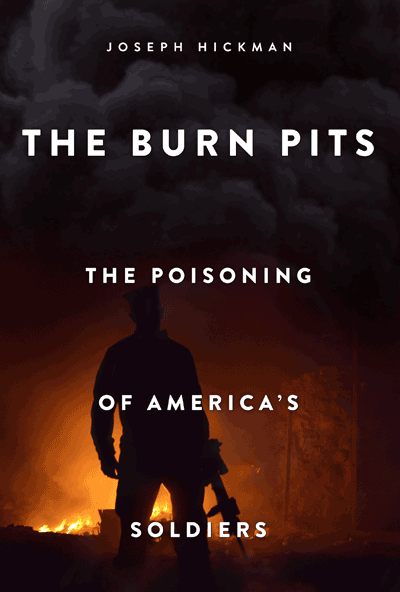Burn Pits ( Harper's-Scott Horton )
— March 30, 2016, 3:44 pm
Joseph Hickman discusses his new book, The Burn Pits, which tells the story of thousands of U.S. soldiers who, after returning from Iraq and Afghanistan, have developed rare cancers and respiratory diseases.
By Scott Horton
In 2004, Staff Sergeant Susan Clifford was stationed at Balad Air Base in Iraq, where twice a month she was tasked with dumping her unit’s waste products—including human body parts and dead animals—into a dirt pit and setting them ablaze. After a year of breathing the pit’s thick black smoke, her health began to decline. Her lungs filled with fluid, and she soon found she couldn’t engage in strenuous physical activity. She was later discharged from the Army with full disability. Clifford’s story, as New York Times journalist James Risen reported in 2010, was typical of a class of new disability cases that appeared to be linked directly to the burn pits set up across Iraq and Afghanistan by a subsidiary of Halliburton. Risen’s article led the Institute of Medicine (IOM) to publish a report on the long-term health consequences of exposure to burn pits, which clearly confirmed the linkage between the pits and debilitating illnesses affecting service personnel returning from the Middle East. But, in the years since, the media has largely ignored the issue. Last week, I caught up with journalist Joseph Hickman, whose new book, The Burn Pits, tells the story of thousands of U.S. soldiers who, after returning from Iraq and Afghanistan, have developed rare cancers and respiratory diseases.
What brought you to this story, and why do you believe it’s not been adequately addressed?
In March 2010, I was the lead source in your article for Harper’s Magazine that exposed details about the death of three prisoners at Guantánamo in June 2006 (“The Guantánamo ‘Suicides,’” Report). In the months that followed, I got phone calls and emails from soldiers who were stationed at Guantánamo, as well as other detainee-holding facilities in Iraq and Afghanistan. Most gave me their support for coming forward, but some also shared their experiences in the field. One evening, I spoke with a soldier stationed at Camp Taji, north of Baghdad. He described how he and several of his friends had been exposed over time to the burn pit there and how he and several others had fallen ill. This was the first time I heard of some of the symptoms that followed exposure to the burn pits. I made a commitment to follow up on it.
For whatever reason, the Defense Department (DoD) continues to deny that the burn pits were a health hazard. Many medical experts also believe the findings on the IOM report finalized in 2011 were not valid because the IOM only studied one of the more than 270 burn pits operating in Iraq and Afghanistan. Also, DoD refused to share the data they collected—such as plume or soil samples taken from the burn pits during their study—with the IOM, which is why the IOM report was basically inconclusive in its findings. The DoD has never offered any explanation for its refusal to share information, but of course it has always been cautious when it comes to sharing information about conditions at bases in a combat zone. But in this case, keeping secrets doesn’t help keep soldiers safe; it puts the health and well-being of soldiers at risk.
What new evidence has appeared since the 2010 disclosures and the 2011 IOM report?
remainder in full: https://harpers.org/blog/2016/03/burn-pits/
